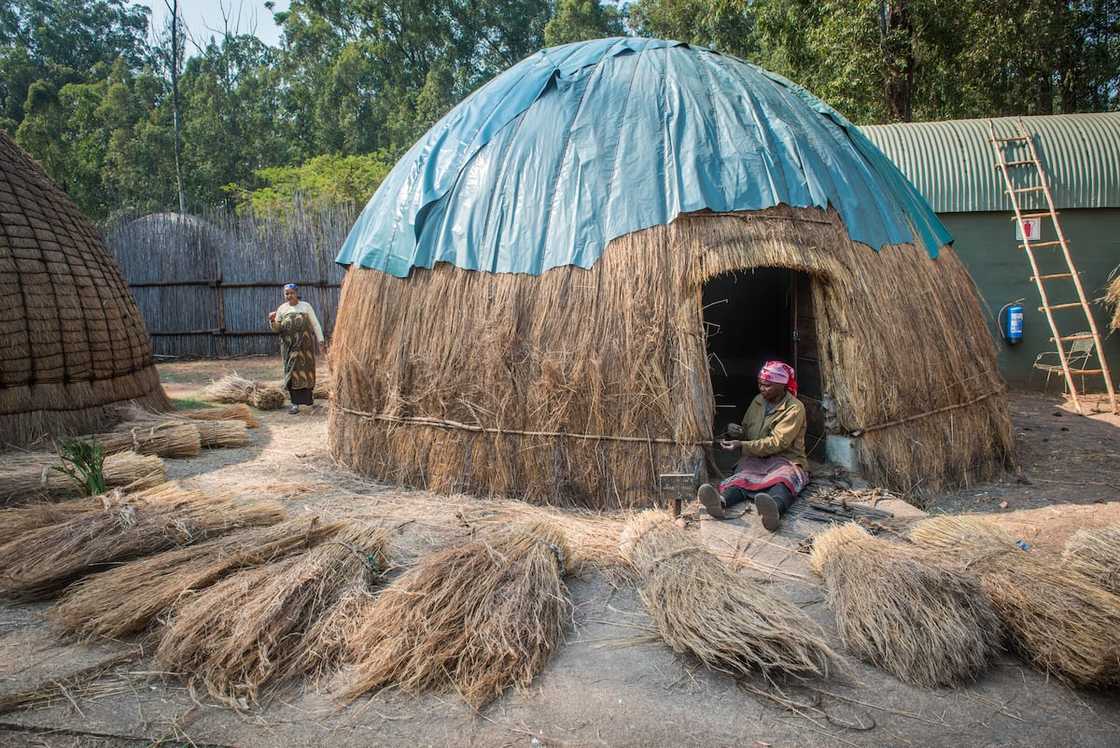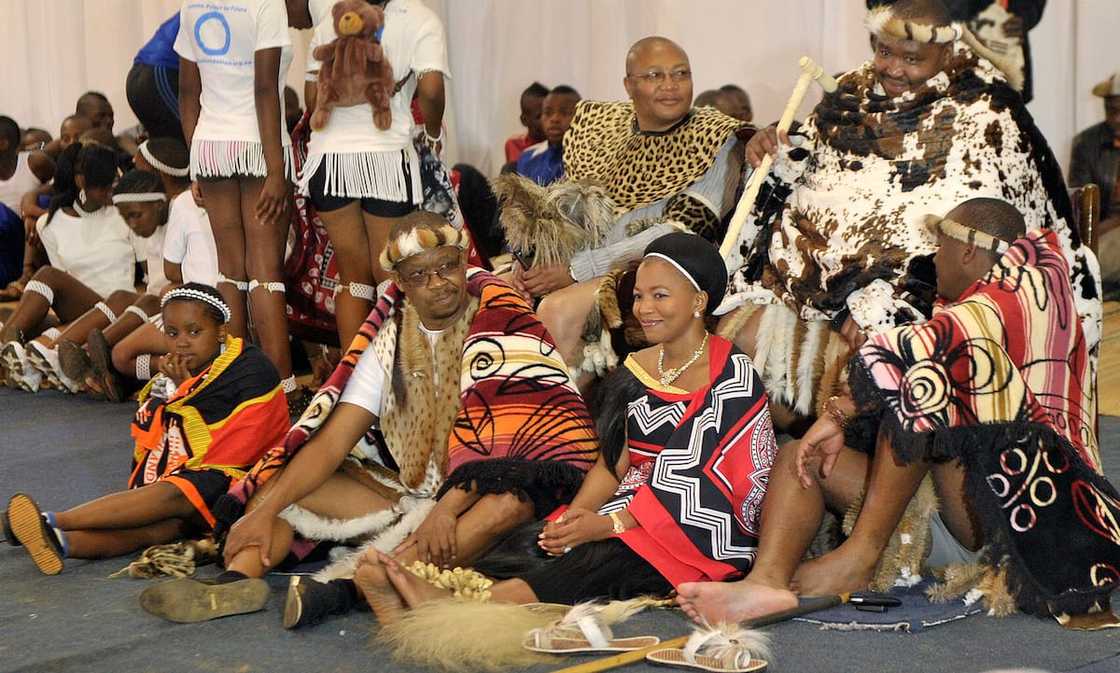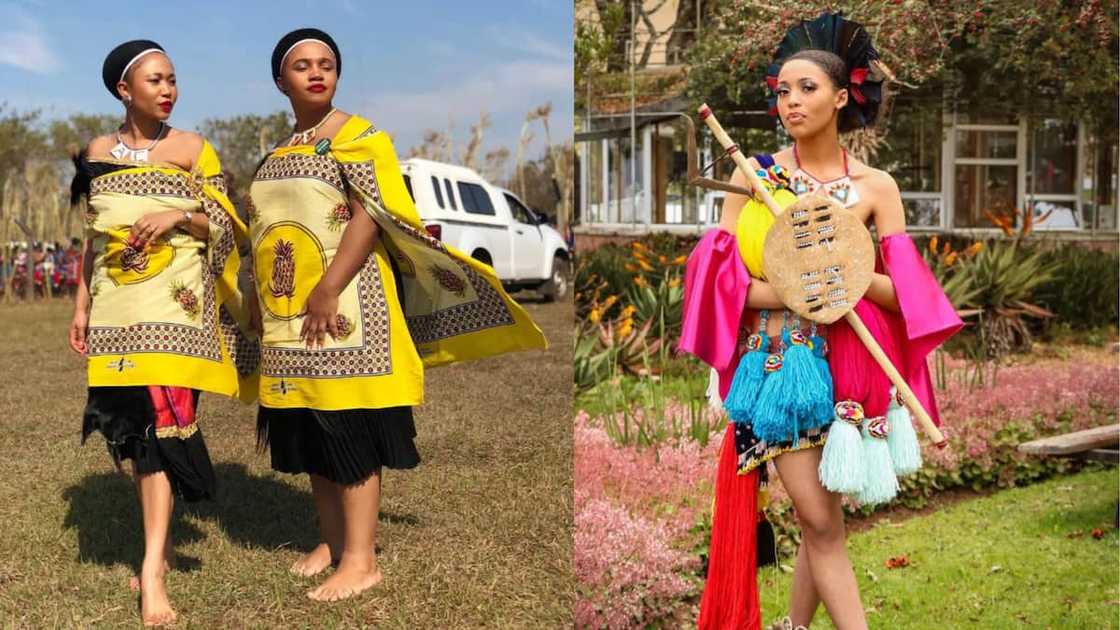Swazi culture: food, clothing, people, beliefs, wedding ceremony
The Swazi are Bantu-speaking people who inhabit the tree-studded grasslands of Swaziland. The Swazi culture is patriarchal, and people from this community are mainly pastoralists and agriculturists.

Source: Getty Images
Did you know there are about 1.81 million Swazi people? Although a significant percentage is based in Mozambique and Swaziland near Mpumalanga Province, some are found in various parts of South Africa due to rural-urban migration.
All about the Swazi culture
The history of the Eswatini people dates back to the fifteenth century. Learn more about the Swazi culture, food, and clothing below.
Origin and location
The Eswatini people hail from Mozambique. Their ancestors, the Nguni Bantus, migrated to Mozambique in the fifteenth century.
Archaeologists have found human remains dated 110,000 years old in eastern Swaziland. Today, this ethnic group primarily occupies the Kingdom of Swaziland and part of Mozambique.
Language
People from this community speak siSwati or Swati. The language closely resembles the Zulu language. It is one of the eleven official languages of South Africa, meaning people use it for official written communication.
Folklore
The traditional beliefs of this community were not affected much by colonial rule. This ethnic group has maintained its beliefs to date.
Ngwane II is known as the community's first king. He united the ethnic group and ensured everyone lived in harmony. Many praise songs were sung in his honour.
The most widely known folktale in this community is of this king. He has two wives, each blessed with a daughter. Mulembe was the older daughter and the child of the king's favourite wife.
She and her mother could do nothing wrong in the King's eyes. The two wore the finest clothes made of the finest fabrics.
On the other hand, Kitila was the King's second daughter with the other wife. Kitila and her mom wore common cowhide clothing. Mulembe and Kitila loved each other.
Kitila grew into a lovely and sweet person. However, she was often pushed aside because Mulembe was always considered the fairest in the land by her father.

Source: Getty Images
Religion
This community believes in a Supreme Being called Mkhulumnqande, who created the Earth. Mkhulumnqande is not worshipped in this community, and neither are sacrifices offered to him.
This ethnic group also believes in ancestral spirits called emadloti, who must be appeased. Emadloti take many forms. They have the power to possess human beings and influence their health. Today, a significant population of Eswatini people are Christians.
Major religious holidays
The major religious holiday in this community is the iNcwala or First Fruit Ceremony. iNcwala is celebrated every year over a three-week period. During this period, there is plenty of singing and dancing.
During iNcwala, young men collect acacia shrubs and use them to build a sacred enclosure where the first fruits of the season are stored for the king. Once the king has tasted the first fruits, everyone else can enjoy the new growing season.

Read also
St Engenas branch of ZCC to descend on Moria for Easter pilgrimage after 3-year pause, ZCC-star won’t attend
Another special religious holiday is Umhlanga or Reed Dance Day. This event is marked every last Monday of August. The dance is done to honour the queen mother called iNdlovukazi. Dancers gather reeds a week before the celebration. On the D-day, people wear colourful clothing.
Rites of passage
The main rites of passage in this community are birth, puberty, marriage, and death.
Birth
The first rite of passage among the Eswatini from Swaziland is birth. When a baby is born, white beads are placed around its waist, wrists, and/or ankles for good luck.
Puberty
When a boy attains puberty, he joined his libutfo or agemates for classes. Special sessions are organised, where boys learn about manhood and service to the community leaders.
On the other hand, girls are isolated in a hit for a few days immediately after they receive their first period. During this period, her mother teaches her about the community's culture, taboos, and observances.

Source: Getty Images
Marriage and wedding ceremony
After puberty, families of boys and girls start marriage negotiations. Once agreed, the groom's family pay bridewealth or lobola to the bride's family.
The lobola ceremony involves giving cattle, money, and other gifts to the bride's family. It is characterised by a lot of singing, dancing, feasting, and ritual wailing. After the lobola ceremony, many couples choose to have a Christian wedding.
Death
After death, the body undergoes various rituals. The social status of the deceased plays a role in how elaborate the funeral rituals are, e.g. the head of the household is traditionally buried by the entrance of the cattle area.
After interment, a widow is expected to continue her husband's lineage by marrying one of her late husband's brothers. Wife inheritance is called ngena or levirate. Today, the ngena tradition is fading away.
Swazi culture clothing
Clothing in Swazi culture is bright and colourful. Today, many people wear traditional outfits to social functions, e.g., burials and wedding ceremonies.
Traditional Swazi attire for men

Source: UGC
The traditional Swazi attire for men comprises a long-sleeved shirt, a long skirt, and a head wrap. The colourful skirt is covered by a leather apron called emajobo. The long white robe they wear is called lihle.
They accessorise their attire with a neckband called ligcebesha, ties called umgaco, and a walking stick called sagibo. Royal people wear red feathers called ligwalagwala.
Traditional Swati attire for women

Source: UGC
Women from this community wear a cloth called ilihhiya. Married women cover their upper torsos. They often wear traditional beehive hairstyles. Single women often wear beads only over their upper torsos during ceremonial occasions.
Food in Swazi culture
Swazis are farmers and pastoralists. They mainly grow corn, beans, sorghum, peanuts, and sweet potatoes and keep livestock.
The staple food is called mealie-meal, a dish made of ground corn. Mealie-meal is normally accompanied by chicken, meat, and different vegetables. The community also brew traditional beer. The most common foods are listed below.
- Umncushu (porridge)
- Buganu (Marula fruit drink)
- Kwangekhatsi (tripe)
- Ligusha (jute soup)
- Inkaka (bitter gourd)
- Lipalishi (maize porridge)
- Chicken dust (barbeque chicken)
- Inyama lebilisiwe (boiled meat)
- Bhatata (sweet potatoes)
- Imbasha (roast Mealie with peanuts)
Family life
Swazi people reside in homesteads called umuti. An umuti typically consists of a man, his wife, and children. Polygamy is not unusual, and a co-wife is called inhlanti.
All family members share responsibilities and eat from one kitchen. Homesteads are built using clay, thatch, logs, and rocks. Traditional homesteads do not have beds or chairs. They use grass mats instead.
Crafts, art, and music
Dance and music are an integral part of this community. The Eswatini have the SiBhaca dance that is borrowed from the Xhosa community. The dance is performed by men and is characterised by the stomping of feet while chanting. SiBhaca dance lasts two or three hours.
Women from this community also sing often, especially when working together. Most of their songs are tributes to various community leaders.
Traditional musical instruments that accompany singing and dancing include the hunting horn or luvene, kudu bull horn or impalampala, and a wind instrument called livenge.
Pottery is the most common art among people from this ethnic community. Many women also engage in basket weaving. Men often engage in the woodcarving of functional items such as utensils.
What do Swazi people eat?
The common foods among Eswatini people are umncushu, buganu, kwangekhatsi, ligusha, inkaka, lipalishi, chicken dust, inyama lebilisiwe, bhatata, and imbasha.
What are Swati known for?
The Eswatini people are known for their elaborate iNcwala and umhlanga ceremonies. iNcwala is the First Fruit Ceremony, while umhlanga is the Reed Dance Day.
The Swazi culture is rich and colourful. People from this community are known for their friendliness, harmonious living, and love for their kinsmen.
READ ALSO: Zulu culture, food, traditional attire, wedding ceremony, dance and pictures
Briefly.co.za recently published an article about Zulu culture. The Zulu culture, food, and clothing are pretty distinct.
People from this community, especially those in rural areas, are known for their pottery, craft-making, weaving, and beadwork. The community is the largest ethnic community in South Africa, with about nine million people.
Source: Briefly News

Peter Kinuthia Peter Kinuthia is a 2018 graduate of Kenyatta University with a Bachelor's degree in Health Services Management. With over five years of copy-writing experience about media, lifestyle, and health affairs, Peter has cemented a solid career in copy-writing/journalism. He previously worked with Ace My Homework before joining the Briefly team in 2017. With over 5 years of experience in Briefly, Peter has become a remarkable wordsmith. (Email: petekinuthia9@gmail.com)

Cyprine Apindi (Lifestyle writer) Cyprine Apindi is a content creator and educator with over six years of experience. She holds a Diploma in Mass Communication and a Bachelor’s degree in Nutrition and Dietetics from Kenyatta University. Cyprine joined Briefly.co.za in mid-2021, covering multiple topics, including finance, entertainment, sports, and lifestyle. In 2023, she finished the AFP course on Digital Investigation Techniques. She received the Writer of the Year awards in 2023 and 2024. In 2024, she completed the Google News Initiative course. Email: cyprineapindi@gmail.com







